Hotel rooms recreated as art by trendy fashion designers
By Lucy Komisar
How would you like to spend a few nights in an art museum? Not possible? How about a hotel room that‘s as exciting and original as anything you‘re likely to see in a gallery? You have never experienced anything like the stunning, stylized, avant garde and traditionally elegant one-of-a-kind new “fashion rooms” receiving guests at the luxury Royal Windsor Hotel Grand Place in Brussels. They are 10 veritable works of art by important Brussels fashion designers and they‘ve been open for less than a year.
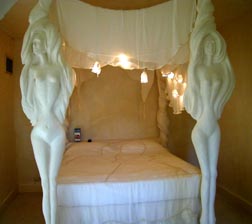
Brussels is a center of grand couture, although its designers are less recognized – perhaps because of snobbery – than their Paris cousins. The idea for the rooms started with a Belgian designer who mused at a cocktail party that the hotel ought to be a showcase for Belgian design. Claude Dufour, Director Sales & Marketing, originated the concept of the fashion rooms. It fit with the Warwick group‘s resolve to make their hotels individualistic and distinctive.
The designers were given budgets and freedom to use them. The first four fashion rooms opened in September 2004, the others in spring 2005, and two more will appear by the end of 2005. The rooms were imagined and created by the designers as if they were their own bedrooms, or the ones they‘d like to have on their travels around the world. Now you can experience their fantasies!
This room by Kaat Tilley, who calls it “the Bride of the Sea,” features an ethereal white voile canopied bed, bathed in light, with two nude white plaster statuettes standing guard at the foot. She says the bed is “the lost intimate element” of the room, “bridal, virginal, all with veils, silk organza, linen gauze, swan feathers, trimmings, fine cotton.” The fabrics are delicately folded and draped. Swan feathers are appliquéd on the bed covers. The theatrical plaster sculptures are “silhouettes of that imaginary woman, muse or guardian of sleep.”
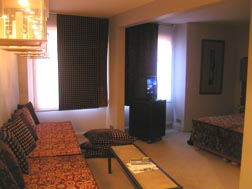
Light is important to the design. The lights and floor lamps are of delicate Murano glass. Arches between alcoves are softly lit, with a chaise draped with white fabric set to catch the light streaming in the windows. The colors are of dawn, the lines soft and curved, ceilings are on a slant. Tilley says the work is made for her “imaginary women – a strong and fragile person, somewhat androgynous.” Her colors, subtle, off-white, or softer than white, express purity and serenity, “a cocoon-like world that envelops you.”
Mademoiselle Lucien‘s red and gold patterned bed, couch and throw pillows sit under lit glass cases with fashion dolls. There‘s a hint of North Africa here; the earth tones and swirling fabrics reminded me of Morocco. Indeed there are Moroccan mosaic tiles, and the geometric designs and colors are warm but subtle. Mlle Lucien‘s calls the design “a journey between orientalism and art deco.” The warm reds and oranges are bright, while the subtle taupe and beige soften the room. Mlle Lucien is really two people, both men: Pascal Di Pietro Martinelli and Laurent Uyttersprot. Before designing clothes, they worked with fabrics for interior designers, and so their synergy between interior and clothing design has a history. Theirs was my favorite room, the place I chose to stay.
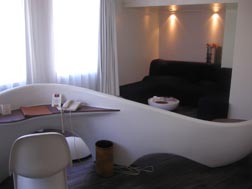
Marina Yee‘s black bed stood out against a sculptured curl of white comprised of a desk on one side and a loveseat on the other; the piece was set diagonally in the center of the room. As she describes her concept, “There are no right angles and no corners. Instead, I have used curves, circles, ovals and convex and concave shapes, which are like rolling waves.” Her colors are shades of white: ivory, chalky white, mother-of-pearl, off-white, matte tones, brilliance on the walls and ceilings. A Chinese cabinet reflects her origins. The entrance hall is red. The lighting is futuristic. She says, “The space breathes light and the light reflects the space.”
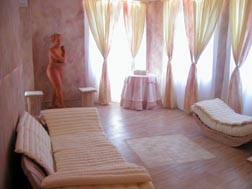
In Nina Meert‘s stunning fantasy of pinky white linen batiste silk taffeta curtains keep watch over white couches and chaises, one meant to resemble a Venetian “barca” that seems to float in the space. Walls are covered with Pompeii frescos. The floor is ceruse wood and Roman stone. A nude Roman statue overlooks the scene. It is a dreamy room, a calm place for serenity and reflection.
Meert describes the room as one inspired by nature: natural fabrics, tones of sunset and flowers. They are the colors found in her couture collection: soft, luminous and powdery. The materials are raw and natural: linen, stone, wood, white and rice powder. But her art and artifice are at work in the lighting. The table, covered in sheer linen, is lit from below. The room is lit indirectly from behind the curtain. The room, she says, is “hushed by space and light.”
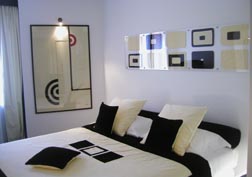
Pascale Kervan‘s black and white square motif moves from the bed to the walls. On the floor is a thick, black carpet; the room‘s fabrics are black and off-white velvet, set off by brushed aluminum and Plexiglass. On the walls are huge of a James Bond-style model in boots and sexy attire. High black leather stools are set against the bar. Kervan says, “There has always been a black and white theme in my collections. Some transparency with the Plexiglass and the glass. Some touches of color provided by the light fittings.” She conceives of the room as a place of total relaxation, with “a touch of modernity that revitalizes classicism.”
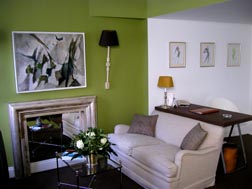
You think you are in a sumptuous upscale surrounding in Gerald Watelet‘s traditional design with clear contemporary lines. The colors are a cool green, blue, white and brown, with a white couch set near a fireplace. The antiques come from the nearby Sablon. The feel is warm, soothing, luxurious. Someone coming here might think they were in their own home. Watelet says he sought to make it “calm but cheerful, elegant but modern, and comfortable but contemporary.” The feeling is “soigné,” well cared for.
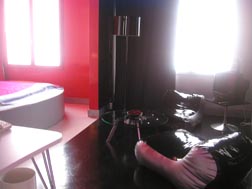
Romy Smits‘s vermillion red and shiny black vinyl futuristic look is the design of a room called the “Rebirth Suite.” The walls are red or black, except for a silvery curve that overlooks the bed. She explains that the bed has “an ovoid and protective form,” and that “the bed plays a major role, this being emphasized by the egg-shape, which alludes to birth and security.” Smits says that the colors of the bedcover include “vermillion red to stimulate sexuality and some bright pink, symbolizing the truth of love.
The sitting room, with black walls “for virtue and health,” features a work called “Tata,” the image of a colored stone found in Morocco and reproduced nine times. Two armchairs provide seating at almost floor level, “as in primitive civilizations,” we are told. This is definitely a room for the spiritually adventurous!
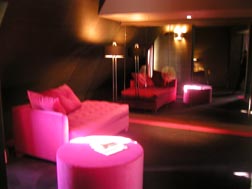
Nicolas Woit‘s bright pink velvet couch and hassock or “pouffe” reflected in a mirror could be in a disco. Bright velvet covers the canopied bed in shades of pink and orange. He loves retro, and this room grew from nostalgia and melancholy for the past. The light is subdued, intimate, the colors dark, smoky brown, aubergine – and the Schiaparelli pink of the day bed. The walls are covered by walnut paneling, velvet or a room-length mirror. The bed‘s canopy is lit with starry lights.
Woit says, “The inspiration came from a 1930s boudoir and then evolved towards the atmosphere of the first forbidden nightclubs of the years of real glamour. Without forgetting late nights in the dressing room of a movie star. Or even imagining the atmosphere of ancient palaces that inspire dreams.”
Consider what sweet or fantastic dreams you will have as a guest in one of these amazing fashion rooms!
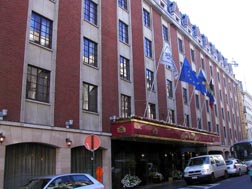
Royal Windsor Hotel Grand Place
5 Rue Duquesnoy
1000 Brussels
Tel. 32 (0)2 505-5555
Fax 32 (0)2 505-5500
Toll free 800 203-3232
Rooms from EUR 225 ($278) & Suites from EUR 450 ($556)
re***************@***********ls.com
Photos by Lucy Komisar.

